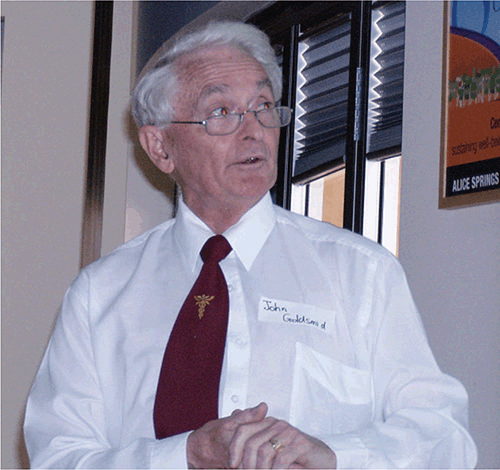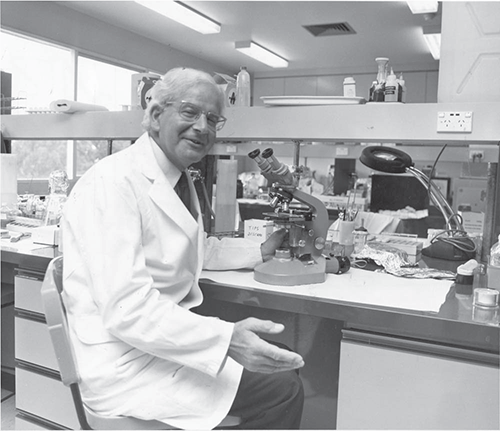ASM Affairs
Microbiology Australia 42(1) 55-56 https://doi.org/10.1071/MA21015
Published: 19 April 2021
Journal Compilation © The Authors 2021 Open Access CC BY-NC-ND, published (by CSIRO Publishing) on behalf of the ASM
Vale: Emeritus Professor John Goldsmid
Richard Bradbury
Email: r.bradbury@federation.edu.au

|
It is with sadness that we inform ASM members of the recent passing of Emeritus Professor John Goldsmid. John studied entomology at Rhodes University in South Africa, graduating with a MSc based on the host finding behaviour of tick larvae. While at Rhodes, he met his future wife, Hilary, and after completing his MSc research, he moved to Zimbabwe, where Hilary was working as a teacher. For a short while he worked as an entomologist, but then moved back into academia, being appointed to a teaching position in the Zoology Department at the University of Rhodesia and Nyasaland. With the formation of the Medical School at what had become the University of Rhodesia (now University of Zimbabwe), John transferred to the Pathology Department, and then to the newly formed Department of Medical Microbiology. John and Hilary were married in Harare and Hilary provided magnificent support and encouragement throughout John’s career.
The post at the University also involved running the Parasitology Department of the Harare Hospital Pathology Laboratory and this allowed John to develop his interest in parasitic diseases and zoonoses, based on the many rare and exotic parasitoses that he encountered in the laboratory. He concentrated on the intestinal nematode infections of humans, conducting influential work on hookworm and the false hookworm, Ternidens deminutus.
John completed his PhD through the University of London under the supervision of Professor George Nelson of the London School of Hygiene and Tropical Medicine. He was then appointed as Professor and Head of the Department of Medical Microbiology at the University, continuing and extending his research into parasitic and other infections, and their identification, diagnosis and treatment.
In 1977, John immigrated to Australia and became a senior lecturer at the School of Medicine of the University of Tasmania. There, he taught microbiology and continued his passionate work in parasitology and zoonotic diseases. He became an advocate for parasitology within professional organisations such as the Australian Society for Microbiology and was the editor of Australian Microbiologist/Microbiology Australia from 1980 to 1995. He also was an early advocate for travel medicine, establishing a Tropical and Travel Medicine Elective unit at the University of Tasmania. Professor Goldsmid’s impact as a diagnostician, researcher, teacher and mentor has influenced many in the field of parasitic and zoonotic disease. John provided many parasitology workshops for ASM members during his time and many will recall his enthusiasm and boundless knowledge, which he so generously shared with us all. John’s many contributions to the ASM supported and developed the society and promoted the profession of Microbiology as a whole. He will be missed and will be remembered with warmth by his colleagues.
Vale Emeritus Professor Solly Faine (1926–2021)
Ben Adler and Julian Rood

|
Source: Monash University Archives, IN1202.
Solly Faine was born in 1926 in Wellington, New Zealand, the son of migrants who had settled in New Zealand from what are now Belarus and Tashkent. He remained very proud of his working-class origins throughout his life. He completed his medical qualifications (MB, ChB) at the University of Otago in 1949. A break in his medical studies to undertake a BMedSci whetted his appetite for research and he went on to complete a DPhil at the University of Oxford (1955) on the topic of virulence in Leptospira. These bacterial species cause leptospirosis, a human and animal disease of worldwide importance. Although he later did branch into other areas, his beloved spirochaetes remained the research focus of his entire career. He gained an MD on this topic from the University of Otago in 1958. He married Eva Rothschild in 1950 and they had three children, Miriam, Susan and Jonathan.
In 1959 he crossed the Tasman to take up a Senior Lectureship at the Department of Bacteriology, University of Sydney, with subsequent promotion to Associate Professor in 1963. He was appointed Professor and Head of Department in 1968 in the then fledgling Department of Microbiology, Monash University, a position he held for 21 of the 24 years until his retirement in 1991. In recognition of his service to Monash University and his standing in the scientific community, he was appointed Emeritus Professor on his retirement.
When Professor Faine took over as Head of Department, the teaching of microbiology to medical students followed a rather traditional path, based on the species of microbes causing infections. While this approach was relevant for diagnostic microbiologists, Professor Faine’s philosophy was that it was not necessarily the most appropriate training for future physicians. He recruited Alan Ferris from the Fairfield Infectious Diseases Hospital to the position of Reader and together they changed the focus to concentrate on infections of body systems, be they caused by bacteria, viruses, fungi or parasites. This systems-based approach has continued in the medical course through to the present day.
Professor Faine played a key role in building the Monash Department of Microbiology into one of the leading such departments in the country and indeed internationally. He was influential in the movement of the department from its location at the Alfred Hospital to the Clayton campus. He recruited Ed Westaway, Peter Wright, Ron Skurray, Ben Adler, John Davies and Julian Rood, each of whom went on to have very successful long-term academic research careers in the department and gave it its well known molecular microbiology and disease pathogenesis focus. His ethos in managing the department was to encourage and mentor, but never to dictate. As such, research group leaders were given the freedom to pursue and develop their own research areas of interest. This approach resulted in a diverse and collegiate intellectual environment that was attractive to many honours and postgraduate students and postdoctoral researchers. He was especially supportive of visiting international staff and students, many of whom went on to become lifelong friends.
Leptospira and leptospirosis remained the love of Solly Faine’s research life; he published over 100 scientific papers in this area. Between him and his long-time collaborator Ben Adler, they supervised 17 PhD graduates whose theses focussed on Leptospira. Professor Faine was also committed to the broader scientific community, both in Australia and internationally. He served as President of the Australian Society for Microbiology from 1969–1970, following in the footsteps of distinguished microbiologists such as Sir Macfarlane Burnet, Professor Frank Fenner and Professor Sydney Rubbo. He served regularly as a WHO consultant on leptospirosis. A regular invited speaker at international scientific conferences, he was recognised as an eminent leader in the field. He was especially respected for his mentorship and support of younger scientists. He served as Chair of the Subcommittee on the Taxonomy of Leptospiraceae from 1978 to 1982 and remained a committee member until his retirement. In recognition of his contributions to the field, a new species of Leptospira first isolated in Australia in 1998 was named Leptospira fainei in his honour. It was the first species to be named after a living leptospirologist.
Professor Faine’s 1994 treatise on Leptospira and leptospirosis was recognised as the definitive reference work in the field and was known colloquially and affectionately as the ‘Gospel According to Saint Solly’. It served as the basis for a second edition in 2001 and subsequently for a completely new volume in 2014, which was edited by Ben Adler.
At home, his enduring 70-year marriage to Eva provided a stable base and a lively social environment. Indeed, his achievements owe much to Eva’s support and sacrifice. In retirement, a booking 2 weeks ahead was essential to visit the Faine home. Each of three grandchildren was endowed with a rocking horse, held together without metal brackets or braces – just hand tooled joinery done with typical exacting precision. Solly and Eva were keen gardeners and ceaseless travellers, a pleasure that they enjoyed well into retirement. He also meticulously applied his scientific rigor to compiling a massive family history that has been drawn upon by relatives close and obscure all around the world.
Solly Faine will be remembered as caring and supportive, especially of students and of younger staff and as a man who always adhered to the highest standards of ethics, professionalism and propriety. The many tributes that flowed from the international scientific community following his passing had a common theme: Professor Solly Faine was a good man. A real mensch. There can be no higher praise or honour.


